Updated: March 2016, with newer posts added.
The Collaborative Economy is a powerful movement that shifts power away from corporations. Over the last several months, I’ve focused my research efforts on the Collaborative Economy a new economic model where there’s shared ownership and access among people, startups, corporations, and governments. They’re using social networks as a conduit to get what they want from each other –rather than inefficient institutions like failed subway systems, taxis or un-interesting hotels. They’re also Making their own goods and products and selling or giving it to each other, unlocking core skills that all humans in villages used to have, but not using technology to learn, share, and distribute beyond physical borders. The impact this can have to opportunity markets all across the globe can offer them new ways to generate income, share what’s valuable, and reduce their dependency on others.
This body of work is focused on answering the following: What role do corporations play, when people get what they need from each other?
To best understand it, I’m living in the collaborative economy. I’ve also conducted field research, using the services myself such as staying in strangers homes, and even let a stranger drive my car for a weekend. For business purposes, I use oDesk, Taskrabbit, CrowdSpring, Zirtual and other crowd based services to get what I need on demand for cheaper. I’ve also made a conscious effort to reduce my consumption of physical goods, I seek to use what I already have, then if I need it, I’ll try to get it used. I keep a purchase log (not including food, personal/health care, business travel) of what I’ve purchased and it’s less than 10 items since June 10th. Yesterday, I visited ScootNetworks and rode their on-demand scooters in SF, and last week PopExpert a service that connects experts to students regardless of location, had drinks with the founder or RelayRide, visited the new AirBnb HQ and two weeks ago took a class on 3D printing at the TechShop a place for Makers.
Body of Work: Index of Collaborative Economy resources for Corporations
To best find this information from one single post, I’ve sorted it into a logical order, rather than rely on search, or the reverse-chrono order that blogs list as a default.
Macro Perspective
- What it means when the crowd becomes part of your company: Simple, clear and concise breakdown of what it means to your company.
- Collaborative Startups Shift from Contractor to Employee Relationships.
- Three major causes of the Collaborative Economy: Find out how over a dozen attributes are cataylzing this movement, organized into distinct categories.
- Past, present and future. See how they all fit in, the internet era, social media era, and the upcoming collaborative economy era.
- The darkside to the Collaborative Economy. A big long list of challenges, oppositions and a realistic look at what could stop this movement.
- A large collection of stats of this industry. Behavior, attitudes, adoption, market and financial impact, growth rates.
- Alliances are forming in this market: See how startups, and corporations are building alliances.
- Sharing is not new. We’ve been doing it forever –but now, we have new technologies.
- Essay: Here’s what Silicon Valley can learn from Midwestern values
- Liberals and Conservatives Both Love & Loathe the Collaborative Economy
- 2015 Is the Year of the Crowd (Slides & Video)
- The Collaborative Economy is Replicating Social Business
- Ten Ways Mobility-as-a-Service Changes Your Lifestyle
Glossary and Terms
- The Collaborative Economy Defined
- A Glossary of Emerging Terms in the Collaborative Economy
- How the Technology of the Collaborative Economy all Works Together
- Collaborative Economy Markets: Platforms, Providers, and Partakers
- Ecosystem Guide: The 12 Players of the Collaborative Economy
- Just call it the economy. There are many titles being affixed to this space, don’t worry about the names, just the end impact.
- Collaborative Economy Spreadsheets: Funding, Industry Stats, Brand Deployments
- A list of over 200 Collaborative Economy startups: You’ll understand the broad reach this movement has across many industries beyond travel.
- A list of corporations and brands that have joined the movement: Less than two dozen corporations enable their customers to share, make, and collaborate.
- Luxury examples of the Collaborative Economy: The movement is about access to luxury –rather than ownership
- Four ways people can get what they want –without buying. Examples of the gift economy, which provide disruptions to brands, retailers, and more
- Maker Movement Industry stats: People make their own goods using shared resources, tools, knowledge –rather than buy them from brands.
Investor and VC Analysis
- Ten Reasons Why Investors Love Shared Transportation
- Valuation: The Real Mythical Creatures of the Collaborative Economy: Centaurs, Unicorns, and Pegasus
- The collaborative sharing economy has created 17 billion-dollar companies (and 10 unicorns)
- How Investors are Sharing their Money into the Collaborative Economy (many graphs)
- Funding Comparison: Social Networks vs Collaborative Economy
- Even More Money Funnels into the Collaborative Economy (Part 3)
- Why Investors are in Love with the Collaborative Economy
- The Collaborative Economy Raises Over $800m In One Month
- The Money Flows in the Collaborative Economy
- Meet the Investors of the Collaborative Economy
- Can Tech Startups Appease Wall Street While Achieving Their Social Mission? Op-Ed, originally on Fast Company
- The crowd has built a car. Using crowdsourcing, 3D printing and crowd services, they’ve built a car.
- Case Example: Brands are sponsoring the movement. See how the largest bike share system in NY is being sponsored by Citibank.
- Google may offer these same features. What happens if Google enables product sharing.
- How Airbnb could be the next eBay, and how Uber could be the next Amazon. A thought piece, with predictions on what happens when tech powers local markets.
- WSJ Essay: The Ups and Downs of Crowd-Based Resources
- 12 Collaborative Services for Success at Work
- How the Collaborative Economy is impacting the Energy Sector
- What to do if these startups are disrupting your business. Pragmatic advice on how to leverage this energy to your benefit.
- Meet the Empowered people. They have been given powers, by big and small tech companies, and are connecting to each other.
- Slides and Data: The Collaborative Economy Disrupts Revenue
- Don’t Protest the Collaborative Economy Lead It
- Google Enters the Collaborative Economy in a Big Way
- Meet the Resilient corporations. Large companies can participate in this market
- Large Companies Ramp Up Adoption in the Collaborative Economy
- The Six Strategies Companies Can Take to Lead the Collaborative Economy
- Is the Crowd a Disruption or an Opportunity for Large Companies? OpEd on the Virgin blog
- Business opportunity “Blue Ocean” new business software needed: In this post, we identified the need for new enterprise class software to emerge to help corporations.
- How Social Business and the Collaborative Economy are related: The first phase of social is sharing of ideas and media, the second phase is sharing of goods and services. They both use same tools.
- The crowd can make companies resilient. Use the crowd to be like bamboo, flexible and fast growing.
- Corporations will emulate the startups: See how it will play out across the ecosystem.
- Six opportunities for Hotels. Perhaps the first to be disrupted, here’s pragmatic advice on what to do.
- Shapeways delivers the promise of 3D printing as a service: See how 3D printing enables local creation, on-demand, customized goods.
- How this movement weeds out the jerks: This movement deploys reputation management, social graph, and insurance.
- Uber and AMEX partnered, expect a new type of customer score to emerge.
- The Collaborative Economy APIs Mean Changes to Commerce, read analysis.
- Here Comes the Collaborative Economy Customer Score
- The Collaborative Economy is for Business to Business
- 8 Brands Using the Collaborative Economy to Market with the Crowd
- A New Industry: These Groups Love Freelancers
- Supply chain impacts: An interview with a Supply Chain expert to see how it will impact.
- Collaborative Economy with Millennials with Dan Schawbel
- Use Case: Company as a Service. Stop selling products, instead rent them.
- Use Case: Provide a Platform: Allow your customers to be part of your company, collaborate with them.
- B2B can benefit from the Collaborative Economy, see these opportunities.
- The many forms of transaction in the Collaborative Economy: Find new business models. I found nine.
- Uber offers a unique value proposition: See how Uber reframes better vs faster vs cheaper.
- 2015 Report: Report: The New Rules of the Collaborative Economy, 2015 Data on the Rise of Sharing
- 2014 Report: Corporations must join the Collaborative Economy: Includes PDF, video, slideshare.
- Study: Why a strong brand matters in the Collaborative Economy, from Fall 2015 research.
- Study: Convenience as a Source of Competitive Advantage in the Collaborative Economy, from Fall 2015 research.
- Study; How To Use Price to Compete In The Collaborative Economy, from Fall 2015 research.
- Infographics: Growth of Sharing in the Collaborative Economy, from Fall 2015 research
- Infographic: A day in the life of the Collaborative Economy: One image, clear story.
- How corporations are deploying in the Collaborative Economy: Includes charts based on over 70 case examples.
- Finding: the Collaborative Economy startups and social networks are intertwined. This is social business, they use the same tools.
- Study: Airbnb loved more than traditional travel sites. Data from NetBase shows how new startups are loved more than traditional ways to book travel.
- Infographic on why startups are proliferating. Using the above sample of 200 startups, the data was analyzed.
- People love Uber over Taxis. Data provided by NetBase.
- Airbnb loved over Hotels. Data provided by NetBase.
- Study: How Corporations are Deploying in the Collaborative Economy.
- Keynote slides on the Collaborative Economy: The long form version
- How companies and crowd share Keynote from the SHARE conference
- Storyboard of the Collaborative Economy. Also featured below
- Report, slides, and video also listed above
Above Image: Honeycomb 2.0, click and access multiple sizes stored on Flickr, Please share widely, with attribution, non-commercially.
The first version had six industries –now it’s twelve
Above: Version 1.0 of the Collaborative Economy Honeycomb
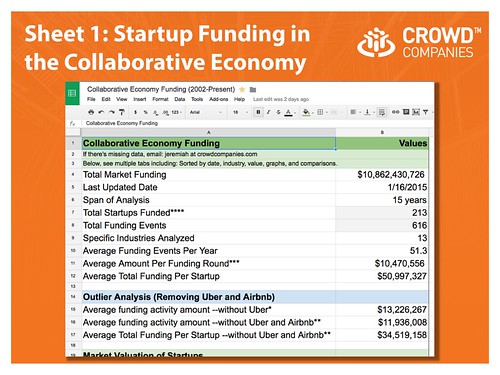
Above: This mature sheet features a comprehensive aggregation of funding in this market, which has ballooned to over $10 billion in a few short years. The workbook has multiple sheets for viewing by market and industry type, funding size, trends by date, and more.
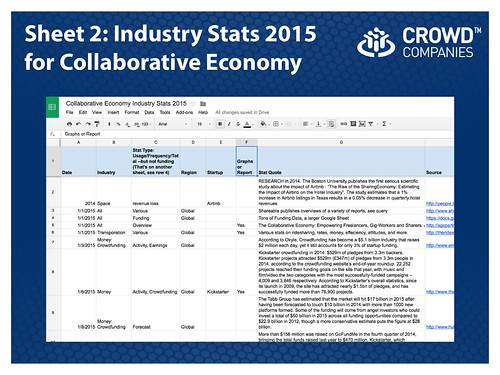
Above: This newly-birthed sheet is still in its infancy. The goal is to collect stats for 2014 and enable it to be sortable for easy reference. I conducted a similar project in 2013, which is outdated, but serves as a useful benchmark for the early days of this market.
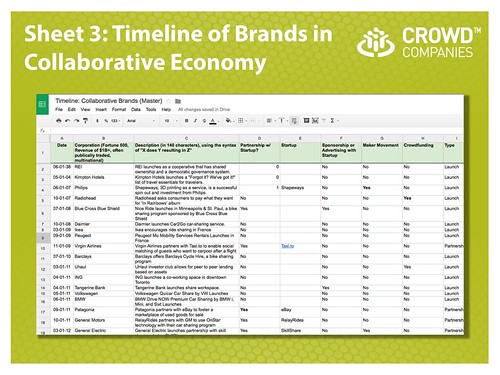
Above: Over a year ago, I started a timeline of brands (first edition) deploying in this market, launched an updated (second edition) version, and designed it to convert into a Google sheet that can be scored and used to derive case frequency information. The analysis is completed and graphs will emerge, shortly.
Infographic: A Day in the Life of the Collaborative Economy (Ver 1.1)
Above: The Collaborative Economy Technology Stack, Version 1.0.
The Future of Business Models #FutureOf from Jeremiah Owyang
The above storyboard clearly encapsulates the business disruptions and opportunities in a clear way for business folks to understand and move into action.
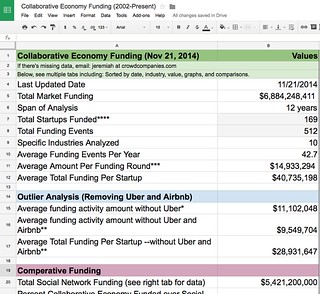
Above: “Massive” Funding Table of Startups
Above: How do these new business models impact retailers?
The above report, partnered with Vision Critical surveys 90,000+ people on how they share in this new economy.
Above image: The Collaborative Economy marketplaces in the maker movement, sharing economy, p2p lending are quickly on the rise
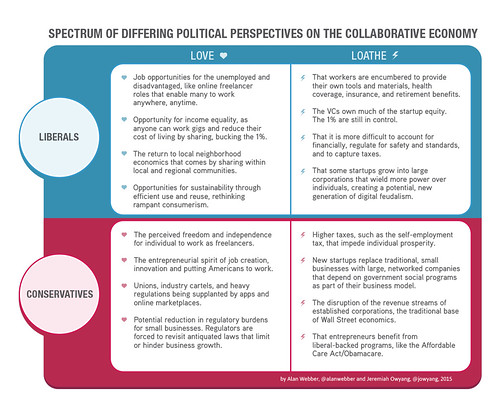
Above Graphic: Spectrum of Political Perspectives on the Collaborative Economy
Above Slideshare: Spectrum of Political Perspectives on the Collaborative Economy, detailed
Video: Power of sharing
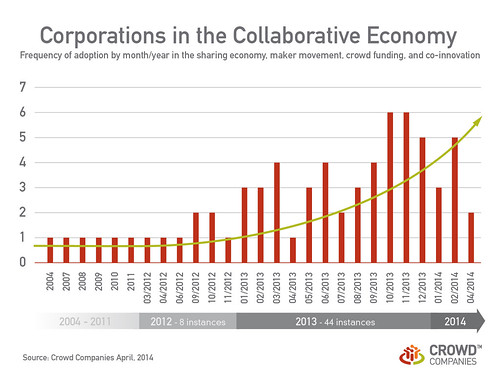






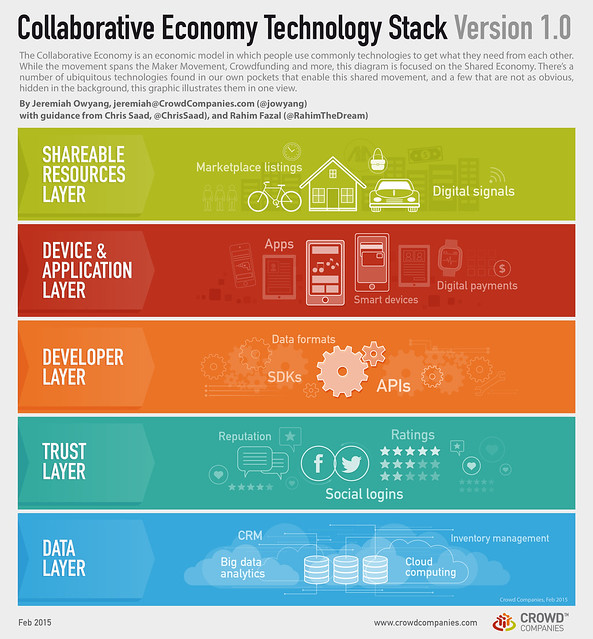
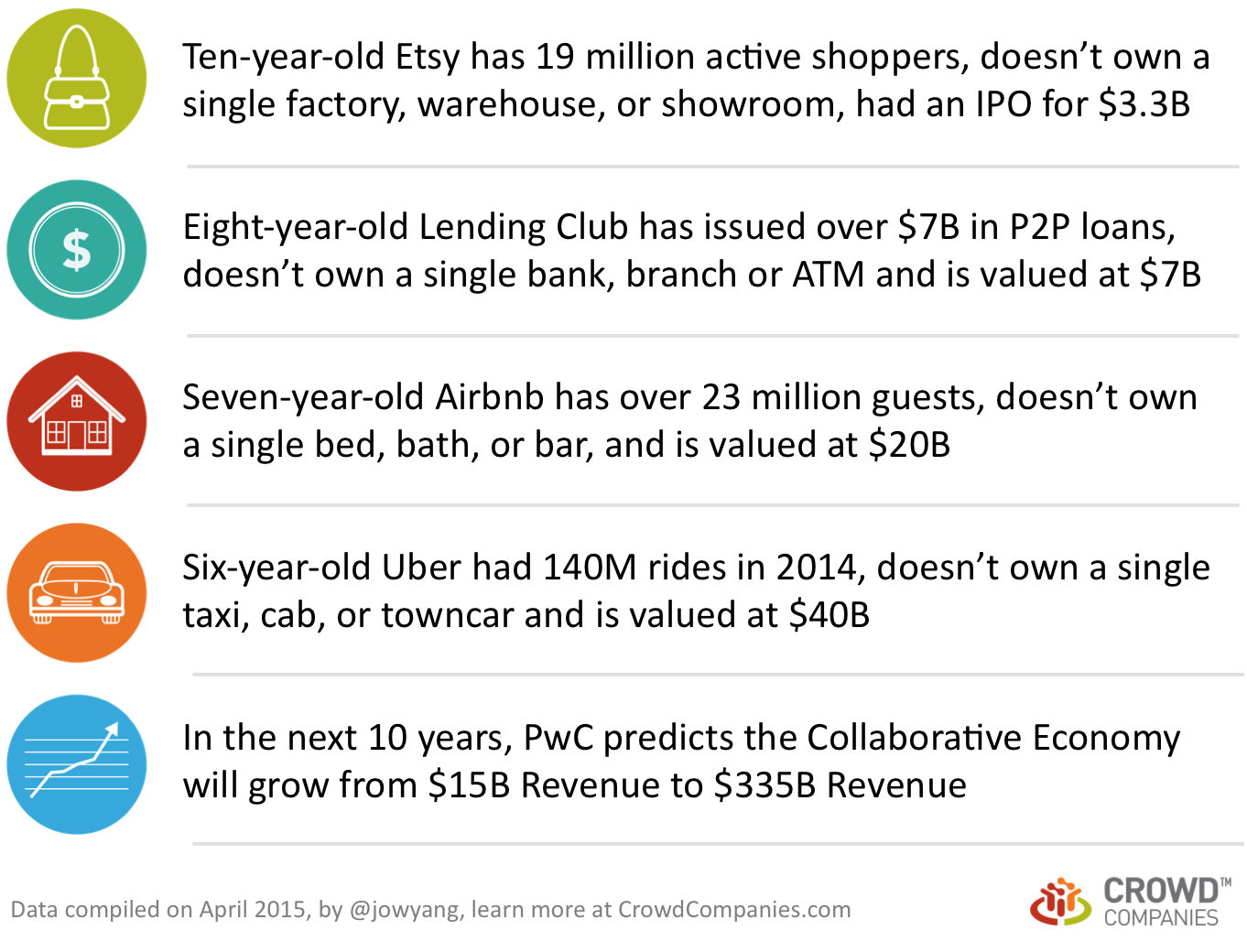

Slide 60 is missing “Co Operation”…
That’s a great point. Imagine if Marriott and Airbnb Hosts were both managing a property.
This is a great guide to the collaborative economy. Thanks for putting this list together, I’m definitely going to be going back to reference is in the future.
Thanks Wendy, that’s very kind of you!
Wow…great idea…how I wish I can be part of your new company. At least you see on the objective side. Most CEO in today’s economy want’s to look good, so when they make decision/s, they make it so that they will look good and not what’s best for the public.
Very inspiring work, Jeremiah. keep it coming!